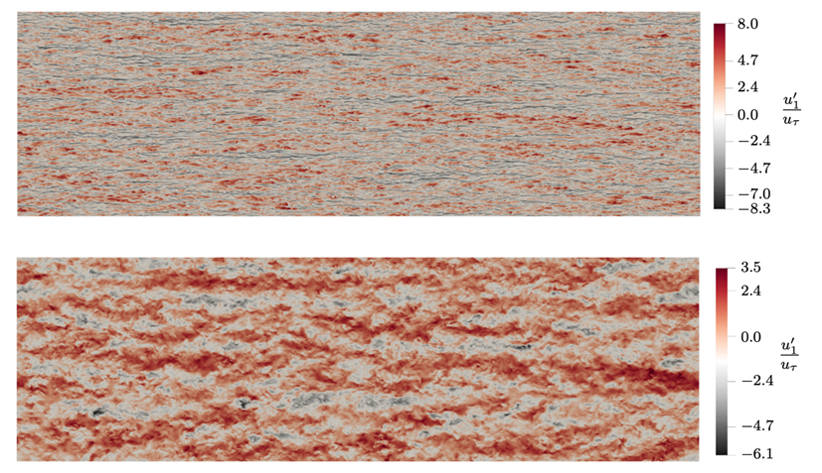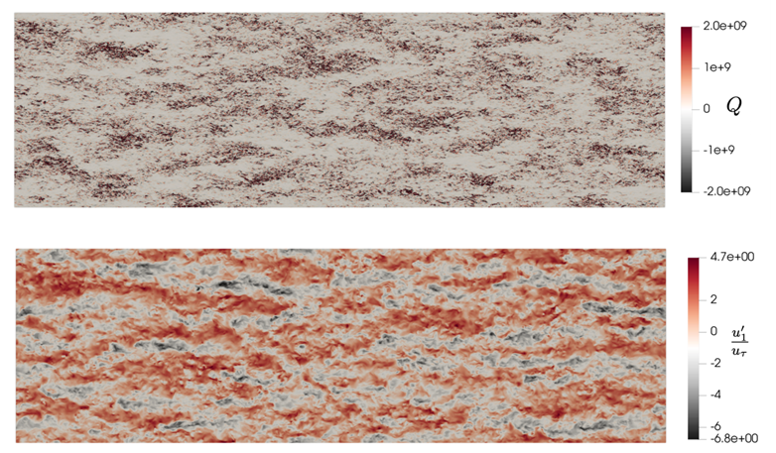ENGINEERING AND CFD
Very Large Scales in Controlled Compressible Channel Flow
Principal Investigator:
Prof. Holger Foysi
Affiliation:
Chair of Fluid Dynamics, University of Siegen, Siegen, Germany
Local Project ID:
osccompchannelvlas
HPC Platform used:
JUWELS BOOSTER at JSC
Date published:
Introduction
The influence of compressibility effects on wall bounded flows is still not fully understood, especially when investigating its interplay with methodologies of drag reduction in engineering type flows. This project dealt with the application of oscillation control to supersonic turbulent channel flow. This method, well investigated for incompressible flow, was analyzed with respect to the influence of compressibility on the control effectiveness, by varying Reynolds and Mach numbers or adding tailored dissipation terms, to separate the effect of intrinsic and variable property compressibility effects. Additionally, the flow control was seen to strengthen the effect of the so-called very large anisotropic scales (VLAS).
Report Summary
Drag reduction in engineering type flows is of paramount importance. However, most flows that were investigated were incompressible flows. Furthermore, the importance and influence of compressibility effects is oftentimes not fully understood. These manifest in intrinsic compressibility effects, describing changes in the dilatation due to pressure fluctuations or variable property effects, due to heating, cooling or mixing of flows. It is not clear, how the interplay of these effects with wall control strategies turns out in general – they could enhance the control effect or even weaken it.
In this project, an investigation to control sub- and supersonic channel flow and the influence of compressibility effects on its efficiency was continued. This so-called canonical flow configuration consists of two cooled walls, restricting the flow at the top and bottom. Due to its simplicity, various compressibility effects can be more easily separated and studied, instead of being masked or overwhelmed by concurring physical effects. This project is a direct extension of a preceding project in Jülich, finishing simulations on very large domains. The utilized control method consists in an oscillatory wall movement, an approach adjusted from a well know technique using temporal oscillations for incompressible flow [2]. The Navier-Stokes solver PyFR [1] was run on the JUWELS GPU cluster. Using tailored dissipation terms, the effect of intrinsic and variable property effects could be studied. In addition to the observation that streaks increase in coherence with increasing Mach number, the flow control method influenced the effect of the so-called very large anisotropic scales (VLAS). The importance of intrinsic compressibility effects could be established.
Details
Turbulent supersonic wall-bounded flows impose several challenges. A huge difference in length scales due to the turbulence structures occurs generally, requiring a very fine grid resolution to resolve the smallest eddies appropriately. The wall cooling required to generate supersonic channel flow leads to huge gradients in temperature, density and consequently viscosity and heat conductivity very close to the wall, leading to large variations in flow parameters like Reynolds and Mach numbers. Additionally, very large coherent structures are generated, responsible for momentum and energy transfer, requiring large domain sizes to capture them accurately, which required the present project extension.
With higher Reynolds numbers, very large-scale anisotropic structures (VLAS) become additionally important, usually being found closer to the channel center. Due to the control, peaks in the corresponding energy spectrum at large wavelengths moved closer the wall and showed less energy decay compared to intermediate and small vortices in the wall vicinity. Therefore, the VLAS turned out to be much more dominant in the controlled flow, consequently influencing the energy transfer in controlled wall-bounded flows significantly. This increased importance on the other hand required simulations of larger domains and therefore high performance computing, to check the appropriateness of smaller domains, necessary to perform the multitude of simulations required when varying flow parameters during the overall project.

Fig. 1: Normalized velocity fluctuations in wall parallel planes are shown exemplarily, at a normalized vertical distance of y* = 20 (top) and at the channel center (bottom).
Fig. 1 depicts the velocity fluctuations in different wall parallel planes, to illustrate the difference and size of the coherent structures observed as streaks. After the control oscillations are applied, the turbulent stresses break down, the wall friction is decreased. Smaller vortices are grouping together to form larger clusters close to the wall – a direct connection to the positive and negative velocity fluctuations at the channel center is visible (Fig. 2).
As mentioned above, the strong gradients and small vortices require a fine computational grid in the relevant regions, whereas the increased importance of the VLAS, after the control is applied, leads to larger domain sizes to accurately capture them. The fine grid in addition influences the time step required to stably simulate the flow, significantly reducing it. Together this results in huge numerical grids and long computation times, requiring supercomputers to be able to appropriately simulate the flows. Here, a more than an order of magnitude larger computation time was required for the largest Reynolds and Mach numbers, compared to uncontrolled flows. For further details please refer to [3], [4] showing results of the first and this second project phase, respectively.
PyFR [1] is especially suitable for these types of simulations. The code generates platform specific code directly at runtime, being able to run on CPUs or GPUs alike. Due to its CUDA backend, it can make full use of the JUWELS booster. Selected simulations used for the characterization of the very large scales and one high Mach number case are exemplarily given in Table 1. 128 nodes (each including four A100 GPUs) were used for the largest simulation.

Fig. 2: Second invariant of the velocity gradient tensor Q at a normalized vertical distance of y* = 5 (top) and normalized velocity fluctuations at the channel center (bottom) for the controlled flow corresponding to Fig. 1.

References
[1] F.D. Witherden, A.M. Farrington and P.E. PyFR: An open source framework for solving advection–diffusion type problems on streaming architectures using the flux reconstruction approach. Computer Physics Communications 185 (11), 3028 – 3040, 2014.
[2] Viotti, C., Quadrio, M. & Luchini, P. Streamwise oscillation of spanwise velocity at the wall of a channel for turbulent drag reduction. Physics of Fluids 21 (11), 115109, 2009.
[3] Ruby, M. & Foysi, H. Active control of compressible channel flow up to Mab = 3 using direct numerical simulations with spanwise velocity modulation at the walls. GAMM-Mitteilungen 45, 2022.
[4] Ruby, M., Foysi, H. Effects by oscillation control and compressibility in supersonic turbulent channel flow, Int. Journal of Heat and Fluid Flow, 114(3), 2025